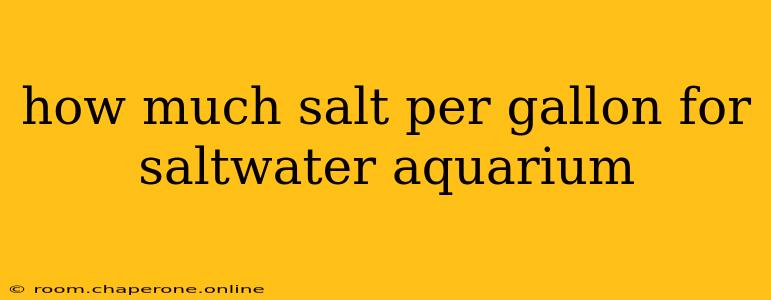Setting up a saltwater aquarium is an exciting endeavor, but achieving the right salinity is crucial for the health and survival of your marine inhabitants. Getting the salt-to-water ratio wrong can lead to serious problems, so understanding how much salt per gallon is essential. This comprehensive guide will walk you through the process, covering everything from choosing the right salt mix to measuring salinity accurately.
Understanding Salinity and Specific Gravity
Before diving into the salt-per-gallon calculation, let's clarify the key terms:
-
Salinity: This refers to the total amount of dissolved salts in the water. It's usually expressed as parts per thousand (ppt) or practical salinity units (psu). For a saltwater aquarium, the ideal salinity range is typically between 33 and 35 ppt (or psu).
-
Specific Gravity (SG): This measures the density of saltwater compared to freshwater. It's a more practical measurement for aquarists and is typically measured using a refractometer. The ideal specific gravity for a saltwater aquarium is usually between 1.024 and 1.026. This range corresponds to the ideal salinity range mentioned above.
It's important to note that the relationship between salinity and specific gravity isn't perfectly linear and can vary slightly based on temperature and the type of salt mix used. Therefore, using a refractometer is the most accurate method for determining your aquarium's salinity.
Choosing the Right Salt Mix
The quality of your salt mix significantly impacts the success of your aquarium. Opt for a reputable brand specifically designed for marine aquariums. Cheap salt mixes often contain impurities that can harm your livestock and negatively impact water quality. Look for brands that provide a detailed analysis of their salt composition, ensuring they contain all the necessary trace elements.
How Much Salt Per Gallon? The Calculation
There's no single "magic number" for salt per gallon. The amount of salt needed depends on the specific gravity you aim for and the type of salt mix you're using. Most salt mixes will provide instructions on the amount of salt needed per gallon to achieve a specific gravity within the recommended range (1.024-1.026).
Instead of focusing on a specific weight of salt per gallon, we strongly recommend following the manufacturer's instructions on your chosen salt mix. This is the most accurate approach, as variations in salt composition affect the required amount.
Accurate Measurement Techniques: The Importance of a Refractometer
While the salt-per-gallon instructions are a starting point, consistently measuring your specific gravity using a refractometer is crucial. This device provides highly accurate measurements and ensures your aquarium maintains the correct salinity.
Here's why relying solely on salt-per-gallon calculations is insufficient:
- Salt Mix Variations: Different brands and types of salt mixes have different compositions, influencing the amount needed to reach the target specific gravity.
- Evaporation: As water evaporates, salinity increases. Regularly checking and adjusting salinity with a refractometer compensates for this.
- Water Changes: During water changes, the salinity of the new saltwater mix must be precisely measured to ensure compatibility with your aquarium's existing water.
Maintaining Optimal Salinity
Once your aquarium is set up, regular monitoring is crucial. Regularly test your specific gravity (at least weekly) and adjust as needed. Small, gradual adjustments are better than large, sudden changes. Remember, maintaining stable salinity is key to the long-term health of your saltwater aquarium inhabitants.
Conclusion
Achieving and maintaining the correct salinity is fundamental to a thriving saltwater aquarium. While understanding the concept of salt per gallon is helpful, it's crucial to prioritize using a refractometer and following the manufacturer's instructions on your chosen salt mix. This approach ensures the health and well-being of your marine life and contributes to a successful and visually stunning aquarium.

